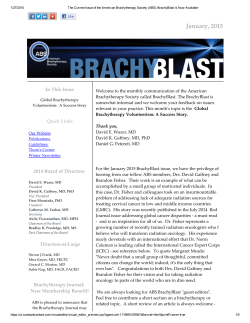
Statement of Mr. Braulio F. de Souza Dias, CBD Executive Secretary
STATEMENT OF MR. BRAULIO F. DE SOUZA DIAS EXECUTIVE SECRETARY On the occasion of FOURTH ACCESS AND BENEFIT SHARING BUSINESS DIALOGUE 28 January 2015 Copenhagen, Denmark Secretariat of the Convention on Biological Diversity United Nations Environment Programme 413 Saint-Jacques Street, Suite 800, Montreal, QC, H2Y 1N9, Canada Tel : +1 514 288 2220 Fax : +1 514 288 6588 secretariat@cbd.int www.cbd.int Excellency, distinguished colleagues, ladies and gentlemen, On behalf of the Executive Secretary, it is my great pleasure to speak to you at the opening of this 4 th ABS Business Dialogue. In preparation for this event, I was reviewing where we were in September 2013 at the time of the 3 rd ABS Business Dialogue. At that time, the Nagoya Protocol had received 19 ratifications and we were undertaking preparations for the third meeting of the Intergovernmental Committee for the Protocol. The ABS Clearing-House was still in the early stages of its development. During the Dialogue, we heard from different countries and regions in the process of developing regulatory frameworks for the implementation of the Nagoya Protocol. We have come a very long way in a very short period of time. The Nagoya Protocol received its 51 st instrument of ratification on 14 July 2014 and entered into force 90 days later on 12 October 2014. This allowed the first meeting of the Parties to the Protocol to be held concurrently with the twelfth meeting of the Parties to the Convention on Biological Diversity from 13 to 17 October 2014 in Pyeongchang, Republic of Korea. At this meeting, the Parties adopted a number of key decisions that have established a solid foundation for the implementation of the Protocol, including decisions on compliance, capacitybuilding and awareness-raising. The ABS Clearing-House has also progressed by leaps and bounds. The pilot phase of the ClearingHouse was launched in February 2014 and, with the entry into force of the Protocol, we launched a fully functional Clearing-House in October. We are now engaged in an outreach campaign to populate the Clearing-House with the necessary records. This will enable users to identify the people to contact when they wish to seek access to genetic resources and the rules they need to follow in a country, contributing to legal certainty, clarity and transparency Implementation is also moving from theory to reality. The EU Regulation has entered into force and now the individual Member States are considering the approach they wish to take to their own genetic resources. The African Union policy framework on ABS is ready for adoption at a ministerial meeting to be held in March. Many other countries are finalizing their domestic process for ratification of the Protocol and putting in place the necessary measures. Of course, challenges still remain – such as the distinction between commercial and non-commercial research, the role of tools such as model contractual clauses and codes of conduct, and the practical meaning of new concepts and requirements introduced by the Protocol. I look forward to stimulating discussions over the next two days to help us explore some of these issues and different ways they can be addressed. Some sectors have already made great strides in this regard. The microorganism community, in particular, is to be congratulated for its work to update its tools in light of the Protocol and to raise awareness of these requirements within the community. I look forward to seeing similar efforts in other sectors. To this end, dialogues such as this one are very important for bringing together the key players to hear diverse perspectives on ABS and to provide information on the Protocol. One of the decisions adopted by the Parties to the Protocol at their first meeting this past October included an awareness-raising strategy for the Protocol. Engagement with the business community is crucial to the success of access and benefit- sharing and the Nagoya Protocol. We must work to build trust and understanding on all sides so that ABS can be seen as an opportunity to build partnerships rather than as an obstacle to be overcome. The CBD Secretariat is thus very grateful to the ABS Capacity Development Initiative and its donors for organizing and supporting this event. We rely on partners to help us spread the word and contribute to raising awareness of the Protocol. We are pleased that this event is building on the ABS workshop organized by the International Chamber of Commerce in November of last year. I would also like to thank the Government of Denmark for its commitment to ABS. Denmark ratified the Nagoya Protocol in May 2014 thus helping to ensure the timely entry into force of the Protocol. The country has also already made information on ABS in Denmark available through the ABS ClearingHouse. As many of you know, target 16 of the Strategic Plan for Biodiversity is that “by 2015, the Nagoya Protocol is in force and operational, consistent with national legislation.” Denmark has done its part to ensure that the world community meets this target. ABS is also key to the sustainable development goals for which 2015 is a critical year. By continuing to host these dialogue sessions, the government can help other countries and other actors to play their part as well. Ladies and gentlemen, It is a great pleasure to see that so many of you have taken the time from your busy schedules to attend this meeting. I thank you for your commitment to ABS, the Nagoya Protocol and the CBD. It is this sort of commitment that is required for turning the words of the Nagoya Protocol into action. In this manner, we can implement the third objective of the Convention and contribute to its ultimate aim: the conservation and sustainable use of biological diversity. Thank you. ----------------
© Copyright 2025





















